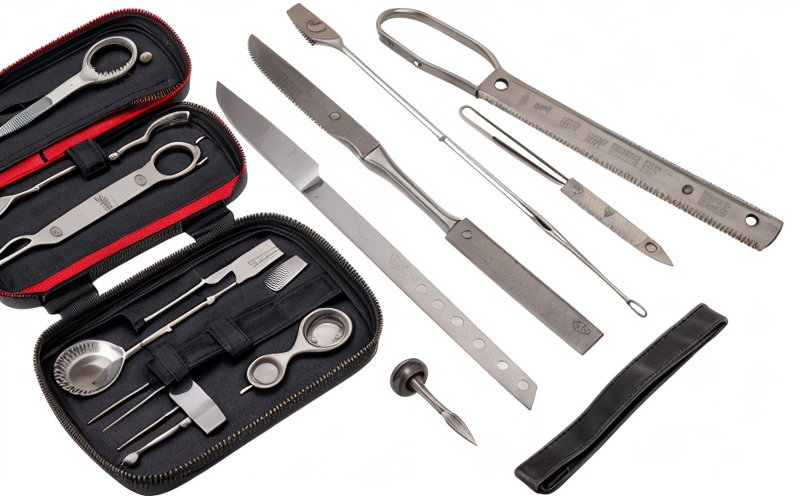Needle Curvature Retention Testing
The Needle Curvature Retention Testing is a critical procedure used to ensure that surgical needles maintain their intended curvature throughout use. This test is essential in the medical device testing sector, particularly for verifying the performance of surgical instruments and tools. The primary purpose of this test is to assess whether the needle maintains its predetermined curvature after being subjected to various stress conditions.
The test involves clamping a surgical needle into a fixture at one end and subjecting it to a specified load or bending force. The specimen is then held in that position for a set duration, typically 10 minutes, before measuring the change in curvature. This measurement helps determine if there has been any significant deviation from the original design specifications.
The accuracy of this test is crucial because even minor changes in curvature can affect surgical procedures and patient outcomes. Therefore, compliance with international standards such as ISO 14971:2016 (Medical devices — Application of risk management to medical devices) ensures that the testing process meets industry-wide expectations.
For quality managers and R&D engineers involved in developing new surgical instruments, Needle Curvature Retention Testing provides invaluable data regarding material properties and design optimization. Compliance officers can use this information to ensure regulatory requirements are met before bringing a product to market.
In summary, Needle Curvature Retention Testing is a vital component of ensuring that surgical needles perform as intended under stress conditions. By adhering to stringent testing protocols, manufacturers can demonstrate their commitment to patient safety and compliance with relevant standards.
| Test Parameters | Description |
|---|---|
| Loading Force | The force applied to the needle during the test, typically measured in Newtons (N). |
| Bending Duration | The time the needle remains under load, usually 10 minutes. |
| Measurement Method | A precise gauge or optical system used to measure changes in curvature. |
| Acceptance Criteria | The allowable deviation from initial curvature, often specified as a percentage of the original value. |
| Material Considerations | Description |
|---|---|
| Copper Alloy | Known for its excellent electrical and thermal conductivity, making it suitable for surgical needles. |
| Surgical Steel (316L) | Austenitic stainless steel that offers high resistance to corrosion and wear. |
| Titanium Alloy | Lightweight and biocompatible, ideal for minimally invasive procedures. |
Benefits
The benefits of Needle Curvature Retention Testing extend beyond mere compliance; they contribute significantly to patient safety and overall product quality. By identifying any deviations in curvature early in the manufacturing process, this test allows for corrective actions that can prevent potential issues during actual use.
For quality managers, conducting these tests ensures consistent product performance across batches, reducing variability and enhancing reliability. Compliance officers benefit from having robust documentation supporting adherence to regulatory requirements, which is crucial for audits and inspections.
R&D engineers gain valuable insights into material selection and design optimization, leading to more efficient and effective surgical tools. Procurement teams can ensure suppliers meet stringent quality standards, thereby maintaining product integrity throughout the supply chain.
In addition to these tangible advantages, Needle Curvature Retention Testing fosters a culture of continuous improvement within organizations involved in medical device manufacturing. It encourages ongoing evaluation of processes and materials, ultimately contributing to better patient outcomes and safer surgical environments.
Industry Applications
The Needle Curvature Retention Test finds applications across various sectors where precision and safety are paramount. These include:
| Sector | Description |
|---|---|
| Bioengineering | Development of biocompatible materials for medical devices. |
| Cosmetics | Ensuring the integrity of cosmetic surgical instruments. |
| Dental Care | Evaluating dental needles and tools used in procedures. |
| Orthopedics | Testing orthopedic pins, screws, and other implants. |
| Surgical Instruments | Description |
|---|---|
| Sterile Needles | Ensuring sterility and correct curvature for use in surgery. |
| Suture Needles | Evaluating the ability to hold sutures securely during procedures. |
| Intravenous Needles | Verifying their strength under various conditions. |
| Laparoscopic Instruments | Ensuring flexibility and durability in minimally invasive surgeries. |
Why Choose This Test
Choosing Needle Curvature Retention Testing offers several compelling reasons. Firstly, it provides a standardized method for assessing the integrity of surgical needles and tools, ensuring consistency across different batches and production runs.
Secondly, this test aligns with international standards such as ISO 14971:2016, which helps manufacturers meet regulatory requirements more effectively. This alignment also facilitates smoother interactions with regulatory bodies and potential export markets.
Thirdly, the test results provide actionable data that can be used to refine manufacturing processes and improve product design. For instance, understanding how different materials behave under stress allows engineers to make informed decisions about material selection.
Lastly, by incorporating Needle Curvature Retention Testing into their quality assurance protocols, organizations demonstrate a commitment to patient safety and regulatory compliance. This proactive approach can significantly enhance brand reputation and customer trust.





